preface to the anglo-american cataloguing rules, second edition
preface to the anglo-american cataloguing rules, second edition
preface to the anglo-american cataloguing rules, second edition
Create successful ePaper yourself
Turn your PDF publications into a flip-book with our unique Google optimized e-Paper software.
There are also some areas in which—looking ahead from current developments andseeking resolution of problems that, for all its excellence, AACR 1 did not entirelyresolve—AACR 2 has introduced some changes and new directions that will lead <strong>to</strong>differences in <strong>the</strong> bibliographic record and in <strong>the</strong> types and forms of heading at which itis displayed. The treatment of description, corporate headings, uniform titles, and fullnessof names are instanced.Such changes have not been introduced without awareness of <strong>the</strong> difficulties that <strong>the</strong>yraise for libraries with large retrospective files. Indeed, <strong>the</strong>se difficulties wereacknowledged <strong>to</strong> be at <strong>the</strong> heart of <strong>the</strong> compromises and occasional inconsistencies inAACR 1 of which, from <strong>the</strong> sheer weight of evidence of <strong>the</strong> need for better resolution,JSCAACR has felt most strongly impelled <strong>to</strong> attempt amelioration for <strong>the</strong> sake of futurepractice. It has also been felt that, with <strong>the</strong> increased flexibility of modern systems forprocessing bibliographic data and of catalogue formats, <strong>the</strong> inertia of <strong>the</strong> retrospectivefile is much less than it has been in <strong>the</strong> past. Many of <strong>the</strong> larger research libraries have, ormay expect soon <strong>to</strong> have, <strong>the</strong> capability of relatively inexpensive conversion of at leastpart of <strong>the</strong>ir catalogues <strong>to</strong> more flexible forms of s<strong>to</strong>rage; and, <strong>to</strong>o, <strong>the</strong>re appearsgenerally a much wider acceptance in libraries of <strong>the</strong> propriety and utility of simplyclosing old catalogues when <strong>the</strong>y become <strong>to</strong>o large <strong>to</strong> respond easily <strong>to</strong> new requirementsof <strong>the</strong>ir users and starting new ones alongside <strong>the</strong>m.JSCAACR <strong>the</strong>refore envisions libraries and bibliographic agencies adopting first those<strong>rules</strong> (principally in part I) <strong>the</strong> application of which has no significant effect on <strong>the</strong>arrangement and collocation of existing bibliographic records, even though somedifferences of style and content may occur between one record and ano<strong>the</strong>r. Theremaining provisions, where <strong>the</strong>y differ from AACR 1 or from previous local practice,may <strong>the</strong>n be most easily adopted at <strong>the</strong> time when newly designed <strong>cataloguing</strong> andbibliographic systems allow earlier records <strong>to</strong> be converted or reconciled or when a newsequence or catalogue is <strong>to</strong> come in<strong>to</strong> being. In this connection <strong>the</strong>re is a chronologicalcheckpoint in <strong>the</strong> announced intention, earlier in 1978, of <strong>the</strong> Library of Congress, <strong>the</strong>National Library of Canada, <strong>the</strong> British Library, and <strong>the</strong> Australian National Library <strong>to</strong>adopt AACR 2 as of January 1981, so that cumulations of <strong>the</strong>ir published bibliographicrecords from that date will reflect <strong>the</strong> new <strong>rules</strong>.SOURCESThe principal published sources for this <strong>edition</strong> include, in addition <strong>to</strong> <strong>the</strong> texts for <strong>the</strong>first <strong>edition</strong> itself, <strong>the</strong> amendments and changes <strong>to</strong> <strong>the</strong> North American text published in<strong>the</strong> Library of Congress Cataloging Service and <strong>to</strong> <strong>the</strong> British text published in <strong>the</strong>Library Association Anglo-American Cataloguing Rules Amendment Bulletin, 1969through 1975; <strong>the</strong> two revised texts of chapter 6 published respectively by ALA and <strong>the</strong>Library Association in 1974; and <strong>the</strong> North American text revision of chapter 12 (ALA,1975).The o<strong>the</strong>r three primary sources for <strong>the</strong> development of <strong>rules</strong> for nonbook materials areNon-book Materials Cataloguing Rules / prepared by <strong>the</strong> Library Association MediaCataloguing Rules Committee. — London : National Council for EducationalTechnology, 1973. — (Working paper ; no. 11); Nonbook Materials : <strong>the</strong> Organization ofIntegrated Collections / by Jean Riddle Weihs, Shirley Lewis, Janet Macdonald. — 1st


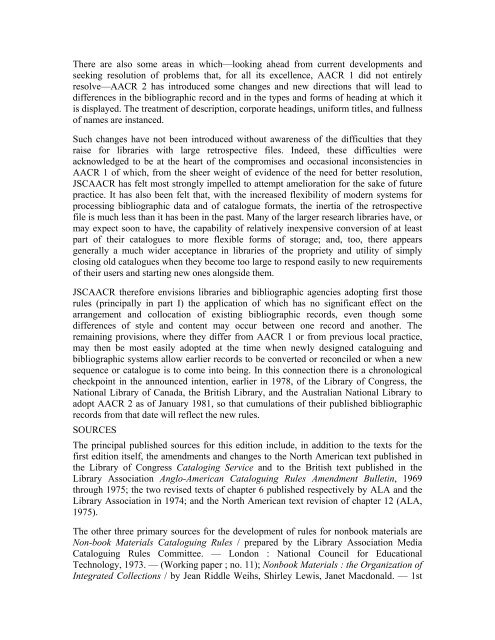

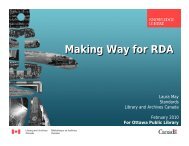
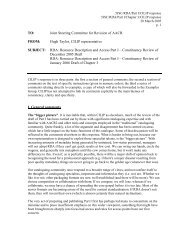
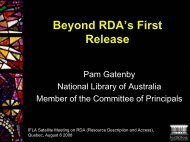

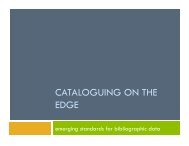

![Presentation slides [PDF] - Joint Steering Committee for ...](https://img.yumpu.com/41621230/1/190x143/presentation-slides-pdf-joint-steering-committee-for-.jpg?quality=85)

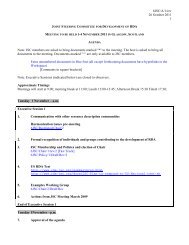
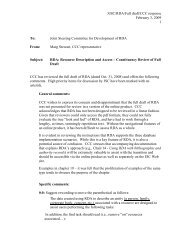
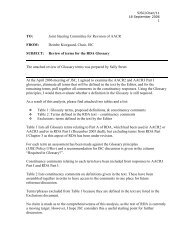
![Presentation slides [PDF] - Joint Steering Committee for ...](https://img.yumpu.com/35256207/1/190x143/presentation-slides-pdf-joint-steering-committee-for-.jpg?quality=85)
